Review: An Attacking Repertoire with 1.d4 vol.1
During the last world championship we saw "Black was the new White", paraphrasing a funny tv-series by Netflix titled: "Orange is the new Black." The TV series is based on a woman who unfortunately goes to jail, and instead of wearing black dresses for cocktail parties she finds herself in the world of inmates wearing orange uniforms. Instead in "Black is the new White..." we could see the over-turn of the common thought that White being the first to move had the advantage. It seems after hundred of years, someone forgot to read the memo on how to pressure Black from the beginning! Pert with this repertoire is going to correct that. If one wants to take d4 as repertoire, or try to improve the 1.d4 repertoire he already has, this is the course to follow to cover the major amount of theory needed to play against 1...d5. (Volume 2 covers 1...Nf6)
In this detailed “two-part” video series I take a look at a main line White system based on 1.d4. This series is aimed at the ambitious player who is looking to put maximum pressure on their opponent from the start of the game.
In a world where after 1.d4 everyone plays the London, it can be refreshing, and quite daunting for our opponents to discover we can play 2.c4!
While the London and other systems for White can be easy to learn, after all, the moves are nearly always the same, they don't teach us how to play in the center, and how to fight for the center.
Personally, I was excited about this product for one reason. I watched many of Kasparov's games, and he clearly used 1.d4 like Morphy used 1.e4, for attacking and killing the opponent from move 1.
I wanted to try to imitate such a champion, but honestly I didn't know whom to pick in order to learn 1. d4 followed by 2.c4.
When I saw Nick Pert made such repertoire, I knew it would be exciting, because he is a player who plays the French defense to slay White, like someone else would use the Sicilian for the same purpose!
Obviously a repertoire after 1.d4 and 2.c4 is huge, and must be broken down in at least 2 DVDs, to give the prospective student the time to assimilate the material. In reality often what we need is an overview, because in chess one must study alone, there is no real way to gain knowledge without applying ourselves. The right teacher can point for us the path we must follow. This helps us to avoid wasting time while experimenting, and discovering what we studied wasn't what we needed. Pert's great tournament experience in the chess arena comes quite handy, and even more important is his experience as coach.
The introductory video sees Pert running through the main variations he is going to teach, in order to give the viewer an idea of what will be covered in this volume.
Let's see a brief synopsis of the different chapters. After 1.d4 d5 2.c4 dxc4, the Queen's gambit accepted, covered in chapter 1, by 9 videos. Pert focused is teachings on 3.e4, and he gives one or two videos to cover each of Black's possible answers. In the following image we can see Black's main answers to 3.e4
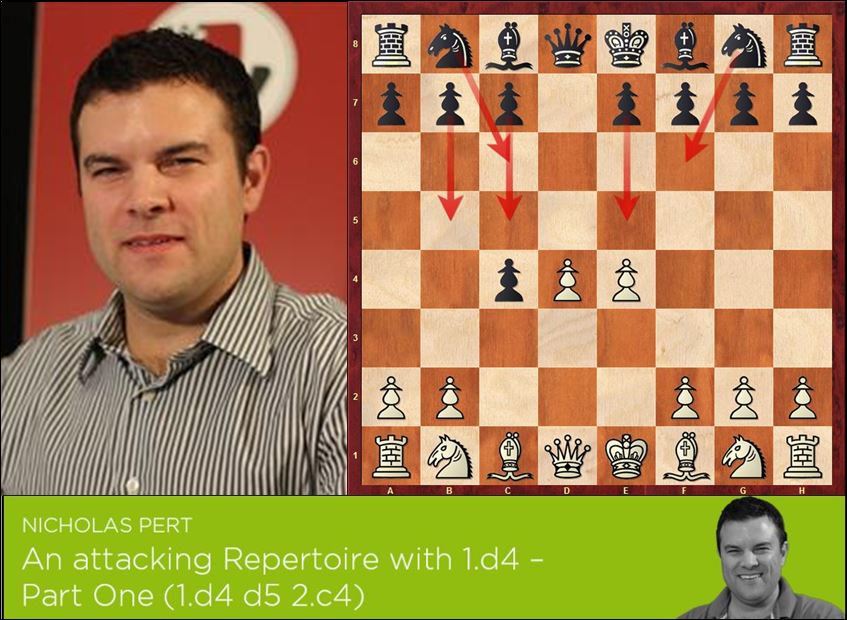
Before I forget mentioning it, the DVD comes with a database of 100 games. However, I believe in the holistic use of Chessbase as the best system for learning an opening, thanks to the integration of different products. For example I use Megabase 2020, which has more than 8 million games, because often I'm not online with my computer, and I can access such wealth of information from everywhere. However thanks to ChessBase, one can have an online account with which to access all the latest games.

In this case I accessed the Live Database, and checked the latest games in the Queen's Gambit Accepted, with the moves proposed by Pert. In this fashion I integrate the wisdom of a GM coaching me through the videos, with learning more upon the patterns and ideas commonly met when playing this opening. I do this for each of the lines taught by Pert. The number of games seen depends on the amount of time a person has. I generally watch a sample of 5 games in which White won, and a sample of 5 games in which Black won, becoming aware of what can go wrong.
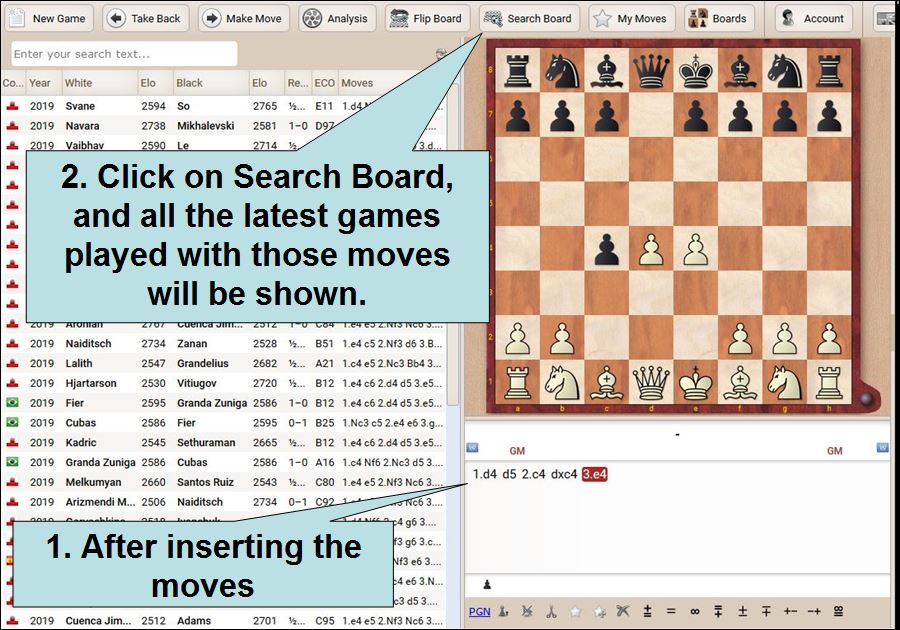
After few clicks I have my sample of games won by White
And my sample of games won by Black.
I don't know if anyone noticed, but out of just 10 games chosen randomly, we have learned a lot about the type of endgames one can enter more often. And then the type of material imbalances typical of this opening.
Thanks to ChessBase there are no excuses for not learning a new opening the right way. And learning a new opening repertoire as adults, since we clearly have less time than scholastic players.
After the Queen's Gambit Accepted (abbreviated as QGA), covered with 9 videos, Pert treats the Queen's Gambit Declined (abbreviated as QGD) with 10 videos. Now the QGD is a very big opening, so big that in fact ChessBase has thematic DVDs dedicated only to some moves. For example it was treated previously in D'Costa-Murphy's DVD.
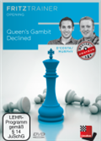 In this second edition of the "Master & Amateur" style ChessBase DVD in English, International Master Lorin D'Costa and chess-software expert Nick Murphy take you through the main ideas of the QGD in an easy to understand, conversational style.
In this second edition of the "Master & Amateur" style ChessBase DVD in English, International Master Lorin D'Costa and chess-software expert Nick Murphy take you through the main ideas of the QGD in an easy to understand, conversational style.And also GM King made a repertoire for Black using the Queen's Gambit Declined. This DVD is even more important, because it can open our eyes on the way Black plays it.
On this DVD Grandmaster Daniel King offers you a repertoire for Black with the QGD. The repertoire is demonstrated in 10 stem games, covering all White's major systems: 5 Bg5, 5 Bf4, and the Exchange Variation.
Why is it important to know about other DVDs by other authors? This is related to chess improvement. In the beginning one needs simple guidelines, and a clear repertoire to follow. Then while improving, one can keep in mind longer variations, and concatenate some chess concepts, while even understanding and remembering the plans for the other side. ChessBase, thanks to many different authors, has already made other DVDs which can help us go far in our quest. This repertoire by Pert is a very important first step in the right direction.
I believe many readers might be interested in how to use tools like the Megabase 2020, to achieve the maximum benefit from their study. I open the Megabase 2020, then I click on board, and insert the moves: 1.d4 d5 2.c4 e6 3.Nc3 Nf6 which is one of the lines covered by Pert.
We can search Megabase 2020 for miniatures, games which have been won in 25 moves or less. Why to make such search? Because it could show us possible dangers inherent to the Queen's Gambit Declined that Black can use against White.
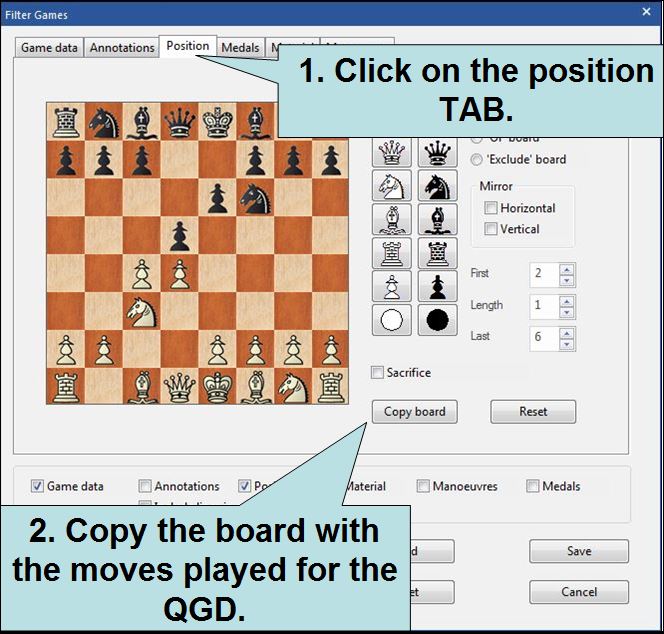
After I copy the position in the filter mask, I click the tab "game data" and under moves I put the values 0-25, and on result I tick 0-1, because I want to be aware of possible traps Black could play.

The result was over 3000 miniatures!! Played between the year 1847 up to the year 2020! As everyone can see we don't need books anymore, and this search took – because my computer and HD are about 8 years old – something like 28 seconds!
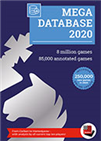 The ChessBase Mega Database 2020 is the premiere chess database with over eight million games from 1560 to 2019 in high quality. Packing more than 85,000 annotated games, Mega 2020 contains the world‘s largest collection of high-class analysed games. Train like a pro! Prepare for your opponents with ChessBase and the Mega Database 2020. Let grandmasters explain how to best handle your favorite variations, improve your repertoire and much more.
The ChessBase Mega Database 2020 is the premiere chess database with over eight million games from 1560 to 2019 in high quality. Packing more than 85,000 annotated games, Mega 2020 contains the world‘s largest collection of high-class analysed games. Train like a pro! Prepare for your opponents with ChessBase and the Mega Database 2020. Let grandmasters explain how to best handle your favorite variations, improve your repertoire and much more.
After the QGD, Pert moves to the Tarrasch, which we have after the moves: 1.d4 d5 2.c4 e6 3.Nc3 c5
The Tarrasch is covered with 4 videos, on chapter 3, the last one dedicated to the Henning-Schara Gambit. 1.d4 d5 2.c4 e6 3.Nc3 c5 4.cxd5 cxd4 5.Qa4 Bd7/b5
Also in this case there are many interesting games played in the Henning-Schara Gambit.
After the Tarrasch Pert covers the Slav, which we have after the moves: 1.d4 d5 2.c4 c6
This is a favorite opening by GM Pert, who also authored a DVD for Black, and which I do recommend. However, the Slav is a kind of oceanic huge opening, like the Sicilian, in which one must remember some lines quite precisely. In fact, on the DVD by Pert he used some lines by the great Morozevich, which are quite long, and quite dangerous for both sides, especially if not played precisely.
This Slav DVD is a complete opening repertoire for black after 1.d4 d5 2.c4 c6. GM Nick Pert has played the Slav defence for over 10 years and provides all his latest and most up to date analysis crammed into one video series. Nick has spent many hours studying the best Slav lines, and he explains his favourite variations, plus includes some interactive clips where the viewer is tested on a range of theoretical questions and tactics arising from Slav games.
For those who want an overview of the Slav, IM Martin has made another excellent DVD:
https://shop.chessbase.com/en/products/martin_modern_slav2nd
Pert for the Slav, as White, advice to play the exchange: 1.d4 d5 2.c4 c6 3.cxd5 cxd5 4.Nc3 Nf6 5.Bf4
Another important opening is the triangle setup. 1.d4 d5 2.c4 e6 3.Nc3 c6
Pert made two videos to teach how to play against it. Another strong GM, Krasenkow, authored a DVD as opening repertoire for the triangle setup:
https://shop.chessbase.com/en/products/krasenkow_triangle_setup_defence_against_d4
Pert covered also rare lines (treated in chapter 7) like the symmetrical position after 1.d4 d5 2.c4 c5
Or the Baltic defense ( which I admit I didn't know it was called Baltic...) 1.d4 d5 2.c4 Bf5
And then there are some important one like the Albin-Counter-Gambit, which can lead immediately to disaster if White doesn't know how to neutralize it: 1.d4 d5 2.c4 e5
On the Albin-Counter-Gambit quite recently IM Trent released a DVD, with the latest theoretical trends and novelties, definitely a must have for players who want to play 1.d4 d5 2.c4
https://shop.chessbase.com/en/products/trent_the_amazing_albin_counter_gambit
And the Chigorin defense: 1.d4 d5 2.c4 Nc6
This opening was also covered recently by the GingerGM (AKA Simon Williams) for ChessBase, in the following DVD:
https://shop.chessbase.com/en/products/williams_the_tactical_chigorin
Volume 1 is over 6 hours. When treating main defenses, like the QGA, Pert treats Black's minor lines and rare moves, to be sure he covers most options. But most of all to tell us about the many complexities we can find in some positions which seem simple, but can trick us.
I found it quite important that Pert treated possible traps and positions we must be aware of, to avoid to waste too much time in a tournament game, for example after the moves: 1.d4 d5 2.c4 dxc4 3.e4 e5 4.Nf3 Nf6 5.Bxc4 Nxe4 6.Nxe5 Bb4 how should White continue?
Pert says White must play 7.Nc3 and gives a very interesting line. But feel free to try it against a sparring partner, like the last version of Fritz!

At the end of the DVD there are 15 interactive test positions. In which Pert presents a position, which was discussed on the DVD, and asks how to continue, giving us feedback for the wrong moves, as well the right ones.
Pro and con: I believe it's important to check every evaluation given by Pert, because often an amateur doesn't have the same understanding a player of Pert's level has.
For example after the moves: 1. d4 d5 2. c4 dxc4 3. e4 e5 4. Nf3 Bb4+ 5. Nc3 exd4 6. Nxd4 Nd7 7. Bxc4 Ngf6 8. O-O O-O 9. Bf4 Bxc3 10. bxc3 Nxe4 11. Nb5
Pert here gives as evaluation: "Nb5 puts pressure on the square (c7) and White has definitely compensation for the pawn, and is probably going to win some material here..."
And after the line thought by the engine up to move 16 Pert says: "White is an exchange up."
Unfortunately, if one sees the line cooked by the engine up to move 27, it is a draw.
Here the game from which this line was taken:
However, some of the lines proposed by Pert lead to great complications, which can be difficult to evaluate for Black, and eventually will make our opponent, if he's not prepared, waste a lot of time.
In general it can be good to play some complicated lines if one needs to win at all costs.
Final thoughts: This DVD should be bought by everyone at every level, because it is a first step in learning chess. Often I heard authors asking us to watch all world championship games in order to improve. But we cannot do that if we don't have an understanding of the main openings, and in order to understand them, we need a vast amount of knowledge many of us simply don't have. Thanks to DVDs like this one, which propose a repertoire and a complete overview, we can acquire that understanding needed to better understand chess, be it watching high level games or just use it for our tournament games. Pert is not selling us a repertoire, he is giving us a map to navigate through the openings with 1.d4 followed by 2.c4. If this map fits our persona, then we have definitely found a repertoire to use for a lifetime. If not, then we have certainly learned some ideas, and can continue our chess journey.























